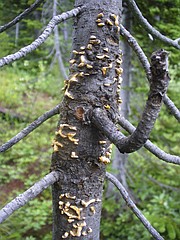Mutual aid
Nick Rotunno | Hagadone News Network | UPDATED 14 years, 10 months AGO
COEUR d'ALENE - The whitebark pine and the Clark's nutcracker have a very special relationship.
A handsome, white-breasted bird with a sharp black beak, the nutcracker likes to eat whitebark pine seeds. It cracks open a pine cone, snatches the seeds and hides them in thousands of caches all over the forest.
Once winter rolls around, the bird returns to its hidden stashes and gobbles up the seeds. Invariably, it forgets where some of the caches are located, and a bunch of seeds will remain buried in the ground.
Some of these seeds germinate, eventually rising from the dirt to become young pine trees.
"So that's why a lot of times when you see whitebark pines, they're growing in small groups," explained Carrie Hugo, a Bureau of Land Management wildlife biologist and president of the Coeur d'Alene Audubon Society. "(Clark's nutcrackers) are unusual enough that when (bird watchers) do see them, it's a treat. It's just kind of a novel thing."
The nutcracker and the whitebark pine are both native to North Idaho. Both live in the mountains that surround Coeur d'Alene, relying on one another to survive. But there's a serious problem afoot: Because of foreign disease and insidious insects, whitebark pines are dying off.
"Whitebark pine is now being considered for threatened, endangered species status," said Forest Service Entomologist Sandy Kegley. "It grows in such beautiful places, high in the mountains, and now it's declining."
The tree is susceptible to white pine blister rust - a nonnative disease that has wreaked havoc throughout western forests - and the mountain pine beetle, which invades pine trees until they ultimately die. Also, due to a lack of wildfires, there are fewer places where the whitebark can regenerate.
"They can't compete real well with other native plants," said Forest Service Pathologist John Schwandt, which is why the trees often grow in burned-out areas.
Kegley and Schwandt discussed the whitebark's decline on Tuesday night, at a free Audubon Society program at Lutheran Church of the Master in Coeur d'Alene.
They talked about the impact of blister rust and pine beetles, the connection between the whitebark, the nutcracker and the grizzly bear (grizzlies also eat pine seeds), and the ways in which the Forest Service is dealing with the whitebark problem.
"The whole idea is to protect the trees out there as best we can," Schwandt said. A whitebark pine, he added, can live to be 1,200 years old, and grow up to 3 feet in diameter.
Pine beetles and blister rust are formidable quarries, but there are countermeasures. The Forest Service has developed a way to block the beetles using artificial pheromones, and progress has been made on rust prevention.
The trees have a fighting chance.
"The relationship (the whitebark) has with the Clark's nutcracker and the grizzly bear is important," Kegley said. "It's just something that people would care about."
Coeur d'Alene Audobon Society meetings are on the second Tuesday of each month at Lutheran Church of the Master.
ARTICLES BY NICK ROTUNNO

Together they're stronger
Hayden military family earns national honor
The cavernous conference room at the Marriott Hotel in Washington, D.C., was packed with people.

Fun in the sun in Cd'A
Vendors descend on downtown for trio of summer events
COEUR d'ALENE - Carli Osika is 15 years old, but on Friday afternoon she didn't sing like a teenager.
Two state bills target fish, game rules
State lawmakers are considering bills that would eliminate the motorized vehicle hunting rule (MVR) in all Idaho Department of Fish and Game units and limit the rule-making powers of the IDFG Commission.



